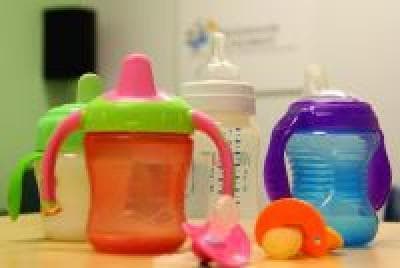Advertisement
Blame It On Binky: Sippy Cups, Pacifiers And A Trip To The Emergency Room
http://www.youtube.com/watch?v=McloiRCH4Ng
At a recent baby shower, a pregnant colleague received a pacifier with an attached fuzzy lamb — easier to find and keep in the infants' mouth. We all oohed and ahhed. But perhaps this darling little sucking device should have come with a black box warning: a new study found that every four hours a child is treated in the emergency department for injuries related to her pacifier, sippy cup or baby bottle.
In what's being called the first study of its kind, researchers estimate that on average 2,270 injuries per year in the U.S. are related to mishaps involving these ostensibly soothing devices. Most of the accidents examined here involved falls with the product in the child's mouth.

The study, published in the journal Pediatrics, and conducted by researchers at the Center for Biobehavioral Health and the Center for Injury Research and Policy at Nationwide Children's Hospital also found (according to the news release):
...that from 1991 to 2010, an estimated 45,398 children younger than three years of age were treated in U.S. emergency departments for injuries related to the use of these products. This equates to an average of 2,270 injuries per year, or one child treated in a hospital emergency department every four hours for these injuries.
The study [released online May 14 and published in the June print issue of Pediatrics] found that baby bottles accounted for 66 percent of injuries, followed by pacifiers at 20 percent and sippy cups at 14 percent. Body regions most commonly injured were the mouth (71 percent) and the head, face or neck (20 percent).
Most injuries were the result of falls while using the product (86 percent), which suggests that children were walking or running with the product in their mouth at the time of the injury.
"Two-thirds of injuries examined in our study were to one-year-old children who are just learning to walk and more prone to falls," said the study's co-author Sarah Keim PhD, MA, MS, principal investigator in the Center for Biobehavioral Health at Nationwide Children's Hospital. "Having children sit down while drinking from baby bottles or sippy cups can help reduce the occurrences of these injuries."
Both the American Academy of Pediatrics (AAP) and the American Academy of Pediatric Dentistry (AAPD) recommend that children be transitioned to regular, lidless cups at 12 months of age. The AAP also suggests that parents try to limit pacifier use after six months of age as use after that age may increase the risk of ear infections.
"These are products that almost everyone uses," noted study co-author, Lara McKenzie, PhD, principal investigator in the Center for Injury Research and Policy at Nationwide Children's Hospital. "Educating parents and caregivers about the importance of transitioning their children away from these products at the ages recommended by the AAP and AAPD could prevent up to 80 percent of the injuries related to baby bottles, pacifiers and sippy cups."
This is the first study to use a nationally representative sample to examine injuries associated with bottles, pacifiers and sippy cups that were treated in U.S. emergency departments. Data for this study were obtained from the National Electronic Injury Surveillance System (NEISS), which is operated by the U.S. Consumer Product Safety Commission. The NEISS provides information on consumer product-related and sports and recreation-related injuries treated in hospital emergency departments across the country.
Both Drs. Keim and McKenzie are faculty members at The Ohio State University College of Medicine.
This program aired on May 15, 2012. The audio for this program is not available.
